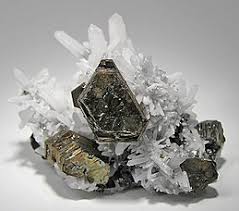Pyrrhotite: Gemstone Information
Pyrrhotite is a significant mineral within the sulfide mineral group, primarily composed of iron and sulfur. Its chemical formula is Fe(1-x)S, where x can vary, indicating the presence of iron vacancies within its crystal structure. Pyrrhotite is notable for its bronze-yellow to brownish-bronze coloration and weak magnetic properties. Here’s a comprehensive overview covering its properties, occurrences, uses, and significance.
Physical Properties:
Color and Appearance: Pyrrhotite typically exhibits a bronze-yellow to brownish-bronze color, often with a metallic luster. It can tarnish to iridescent colors like purple or blue.
Crystal Structure: Pyrrhotite crystallizes in the hexagonal crystal system, forming elongated prismatic or tabular crystals. It may also occur in granular or massive forms.
Hardness: It has a Mohs hardness ranging from 3.5 to 4.5, making it relatively soft compared to many other minerals.
Density: The density of pyrrhotite varies depending on its iron content, typically falling between 4.58 to 4.65 g/cm³.
Magnetic Properties: Pyrrhotite is weakly magnetic and exhibits variable magnetic susceptibility, which changes with temperature and composition.
Chemical Properties:
Chemical Composition: Pyrrhotite is primarily composed of iron and sulfur. The iron content may vary due to the presence of iron vacancies within its crystal structure. It forms a solid solution series with troilite (FeS).
Solid Solution: Pyrrhotite forms a solid solution series with troilite (FeS), where the iron content decreases as the sulfur content increases.
Occurrences:
Pyrrhotite occurs in various geological environments, including igneous, metamorphic, and sedimentary rocks.
It is commonly found in association with other sulfide minerals such as pyrite (FeS2), chalcopyrite (CuFeS2), pentlandite ((Fe,Ni)9S8), and sphalerite (ZnS).
Significant occurrences of pyrrhotite include ore deposits associated with nickel, copper, and precious metal mineralization, as well as in hydrothermal veins, pegmatites, and skarns.
Uses:
Ore Mineral: Pyrrhotite is an important ore mineral for the extraction of iron, nickel, and other metals in mining operations. It often occurs in significant quantities within ore bodies containing valuable metals.
Industrial Applications: In addition to its role as an ore mineral, pyrrhotite finds use in various industrial processes. It is used in the production of sulfuric acid, iron sulfide-based pigments, and as a component in the manufacturing of magnetic materials.
Geological Studies: Pyrrhotite serves as a valuable indicator mineral in geological studies. Its presence can provide insights into the formation and evolution of ore deposits and hydrothermal systems.
Significance:
Pyrrhotite plays a crucial role in the global economy as a source of iron, nickel, and sulfur, supporting industries such as steelmaking, electronics, and chemical manufacturing.
Its occurrence in specific geological environments helps geologists identify prospective areas for mineral exploration and resource development.
Pyrrhotite’s magnetic properties make it useful in scientific studies such as paleomagnetism and rock magnetism, providing valuable information about Earth’s magnetic field history and geological processes.
In conclusion, pyrrhotite is a significant iron sulfide mineral with diverse occurrences and applications in various industries. Its properties make it valuable not only as an ore mineral but also in geological studies and industrial processes, contributing to our understanding of Earth’s geology and supporting economic activities worldwide.





